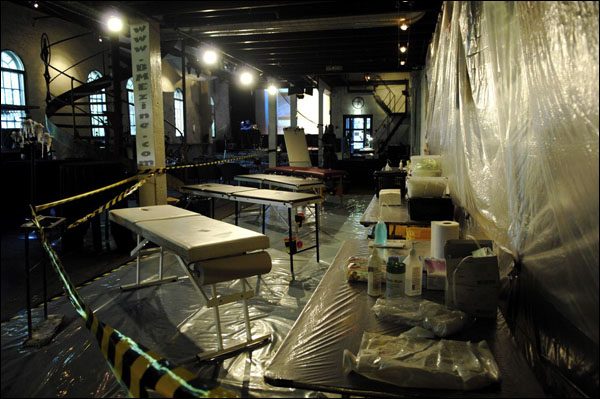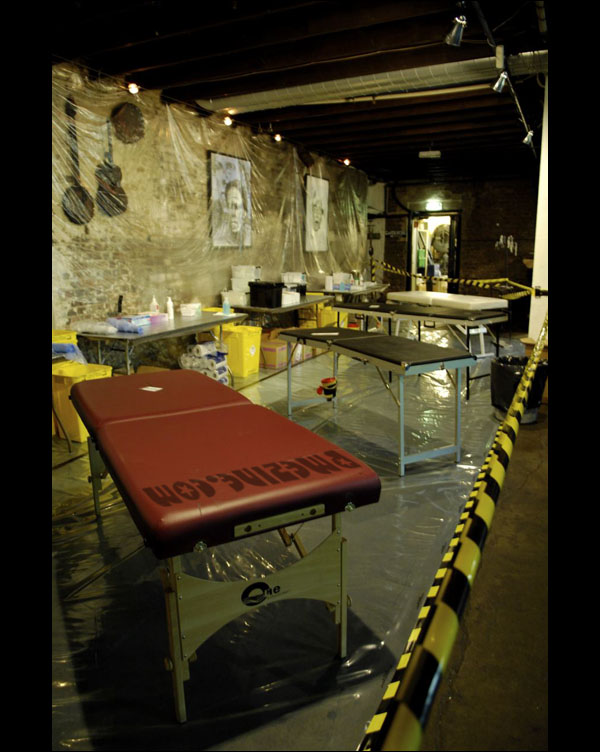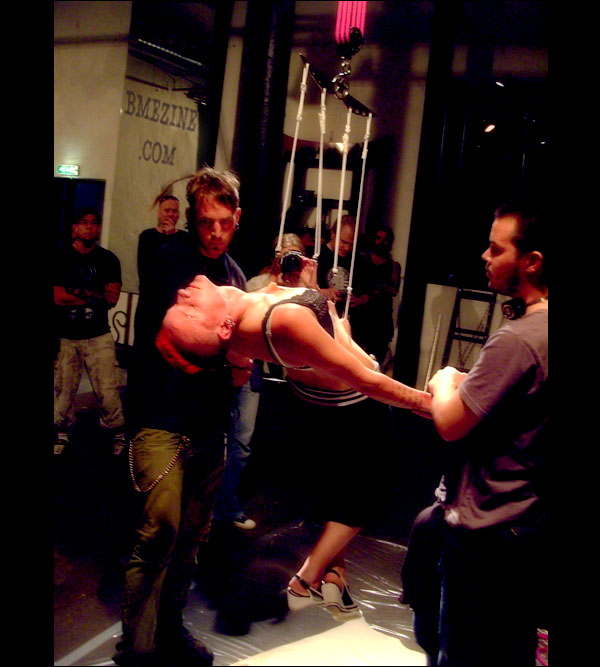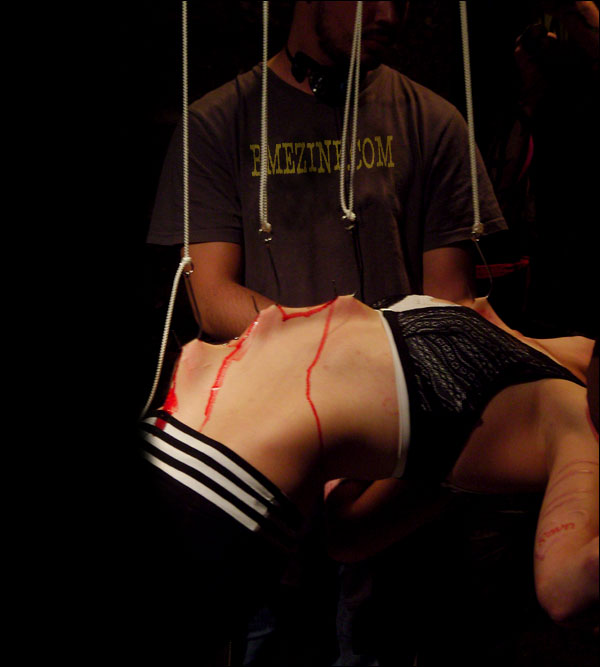Welcome to BME’s Big Question! In this weekly (hopefully) feature, we’re going to ask a handful of the community’s best and brightest piercers, tattooists, heavy mod practitioners and shop owners for their opinion on one question or issue that’s affecting the body modification community. Many, many thanks to all of the contributors.
If you’d like to be a part of future editions, or if you have an idea for an issue or question you’d like to see addressed, please e-mail me.
This week’s topic:
* * *
 |
I think, and am noticing, that business is slowing down quite a bit, but it normally does around this time of year here every year. It seems slower than normal, but going through my books, it isn’t.
I think that people will continue to get tattoos/piercings/etc. done even when the economy is bad because they make them feel good about themselves — even though they aren’t necessities. Much like sales of alcohol, drugs, cigarettes, etc. don’t really get affected like other industries (restaurants, movie theaters and so on) by the economy, I think body modification will be just fine overall. It just seems that people are opting for cheaper plain jewelry instead of going with the fancy jeweled piece more often now though. |
 |
A lot of people around Syracuse work in factories. New Venture Gear/ Chrysler is one of the larger ones, and they have been laying people off since the end of last year. Before them there was Carrier, which ended up closing. With these lay-offs, there are thousands of people with no work. I’ve definitely noticed a slight drop in the amount of business we are doing which I definitely relate to the local economy. But like Steve said, it’s not that I’m really doing fewer piercings, I’m just using less expensive jewelry. People aren’t getting the gems as often, and I’ve received far fewer requests for the more expensive plugs.
I’m also seeing more and more people coming in after getting work done somewhere else — usually with very low quality jewelry, poor placement, the wrong aftercare information, and all sorts of irritation. While I’ve always had people come in to get things fixed from these other places, the number is definitely increasing. |
 |
As both a piercer, and someone who works in a wholesale situation, I have totally noticed a drop in business on both ends.
As for piercing, we have recently dropped from doing about $3,000 a day or more to an average of about $1,000-$2,000. That’s a big drop for us. Being in NYC especially makes it worse; people feel the drops in the stock market a little more keenly I think. People are more conservative with their spending now, and the idea of luxury, except for the very wealthy, is a back-burner thought. Thankfully, we do have some of those clients keeping numbers high. But, yeah … sales are lower, and people are price shopping more, and with the cost of gold climbing, that makes it really hard on us at times. But we make it. |
 |
Sure, the economy is in the crapper — that is indisputable. Guess what: it’s probably going to get worse.
What we do for a living makes someone who is not feeling well feel good about themselves. I do not see it getting so bad that it comes down to “food or a piercing, but it is that fear that keeps people from spending extra money on an item such as a piercing. We are all going to feel “it.” It’s time to get back to the basics, such as customer service and quality. That way, when someone does want to spend their hard earned (and slim) money, they will come to you — that person who treated them the best. Anatometal has been hammered with orders right up until today. Not sure what tomorrow will bring, but make no bones about it: We are busy. Jewelry (including body jewelry) has shown to be one of the more “recession-proof” items out there. No, we are not talking about big ticket items — those who can afford those will afford them no matter what. My point: girl walks into a tattoo shop because she has nothing better to do. She just got laid off, and she wants to get a tattoo, but that $125/hour rate is a bit much for her. Instead she walks out with a $40-60 piece for her navel. She feels better about herself and helps this economy at the same time. Retail therapy works and works very well for not just that girl with the new navel bling; it also works for people like you and me. We are up 10 percent from last year, and up 33 percent from two years ago. I attribute this to our customer service staff and our great customers. |
 |
Barry, are you noticing more sales of basic items than the fancier pieces right now? More than usual, I should say, since I’m sure basic plain pieces are always going to be the biggest seller.
Over the last year almost every microdermal I did was with a gem on it; now only about a third are. And up until about two or three months ago, I couldn’t remember the last time I’d pierced a navel with a plain curved barbell — now I haven’t used a jeweled curve in maybe two months. |
 |
Basic stuff will always do well for those wanting a new piercing. The catch is to get those people in your environment and treat them just how you would want to be treated.
We don’t do too much “super high-end” stuff like what Meg works with, so it’s hard for me to judge. Gemmed eyelets are most certainly a bit down, but that started after other companies started putting out similar designs. Just today, I noticed a lot of gold going to places like Japan — more than usual, even. To answer your question Steve: it appears to be that orders are not much different than they were just a few months ago. |
 |
I’ve never worked in a busy 30-piercing-a-day type shop, so I never expect things to be “busy,” but I’m honestly not noticing any decline in business for myself. If anything, I feel like walk-ins are growing for me, but I attribute that greatly to keeping my pricing as low as is economically possible. Since I seem to have a great reputation in the area for piercing, especially with the college crowd, that’s definitely what keeps me working.
I certainly know, based on the levels of standards of sterility and jewelry quality, I should be charging more, but unfortunately, many people in the city will not pay more. Now that I attribute mainly to lack of information and legislation for possible clientele. If a client comes into the shop and allows me to educate them, very rarely will they leave without the work, but if people know you charge more, they just don’t bother coming in at all. I seem to have found the perfect pricing to maintain clients, but even still, being that I do charge more than most other shops in the area, bunches of people still nearly faint when I tell them the prices. For these people, I really just blame the cost of living in NYC. It’s true, piercing probably isn’t a necessity for most people, so if they don’t know better and can get it cheaper, of course they’re going to. Barry, I’m curious, with the orders you’re getting, how much of that is from select, enormously busy shops that have been ordering like that for years? You obviously produce unmatched quality, but also obviously more costly than, say Wildcat or BMS, which I’d suspect makes it harder for the smaller shops to exclusively stock your entire line, no? I’m very curious, how many shops in NYC stock your basics? |
 |
The orders I get are based on customers like yourself, Brian — you too, Steve.
From the start, we have not had much business out of NYC, so that’s not really something I can go by. Any shop that’s been ordering from us for the duration knows what I know: piercings as a whole have declined over the past ten years. At the same time, jewelry sales have gone up. Perhaps not for all of you, but as a whole? Body jewelry is doing well. Those who have visited Anatometal should know its more of a “mom and pop” type atmosphere. It’s shops like yours, Mr. Decker, that I prefer to cater to, and perhaps that’s why things are the way they are at my work. Sure there are ups and downs, but it seems when one area is down another picks up, and so on and so forth. It’s sort of hard for me to judge unless I do a year-to-year comparison. I have my bookkeeper working on that for September ’07 versus September ’08. October is a better “judge” as it’s typically our slowest month of the year. Because of the current economic status in America, just know I am watching things very, very closely, looking for the signs, just like everyone else. I do think that we stand out and sell to a select crowd, Brian — no different than Tiffany & Co. would in the world of standard jewelry. I would like to see how places like BVLA are doing. |
 |
I completely understand what you’re saying, and I love you for that (as well as for other things), but let’s be honest: I don’t spend thousands of dollars per order with you. I wish I had to, but I know it’s not me paying your bills. That’d be places like HPP or old Dragon FX, I’d assume.
|
 |
It’s the sum of all the “Decker Shops” that are the brunt of our business, and I monitor this very closely.
Some of you will remember that there was a day when we were the biggest in the USA. I don’t ever want to go back to that again as you cannot have that and those three things mentioned above. I turn down anywhere about 25 percent of new clients, even in this economy. I want to be able to serve the clients I have now and in the future. |
 |
To keep our costs down, we make all of our own steel posts, both straight and curved. The only things we are ordering from “the outside” are balls, surface bars, microdermal bases, and the occasional large gauge items.
On the wholesale side, we get a few orders per week, and they are generally for at least $1,000. We ask people how stuff is selling, and they all pretty much tell us the same thing: that it all sells at a good rate. I’m not sure how these shops are charging in comparison to how we charge in our retail store; it would be interesting to find out actually. I’ve noticed in the retail store we are doing more piercings lately than in past months, but the jewelry is really, really basic — lots of white gold fixed ball rings in cartilage, 1.2 mm. diamonds in nostrils, and our basic $135 gold/CZ navel combo. We’re still getting the bigger ticket items to move, but it’s a little less than in past months. On Sunday, we did $3,000. Monday, we barely did $700. It’s fluctuating a lot more, and with October being historically slow, it’s hard to gauge whether it’s the typical time of year drop, or economics. I will say that I did have a client tell me how he just lost half of his money in a stuck crash in recent weeks. He talked about how hard it is for him right now, and how bad things are with everyone he knows. Then he bought a $550 navel piece for himself. |
 |
I think we can all agree on one thing: we are all okay. Sure, we are not where we would like to be. Even Meg’s stock broker can agree with that.
I can say where the economy has affected us, and it’s not exactly where this topic started: the cost of materials went through the roof over a year ago. Stainless, Titanium, and yes of course: gold. We tightened our belts a year ago, and perhaps that’s why the little Anatometal engine keeps chugging along. |
 |
The cost of gold is a pain in our ass.
|
 |
Real numbers:
September ’07 to September ’08: Eight percent growth, and that’s about spot on correct considering all that is going on around us. The October numbers will paint a much clearer picture. |
 |
I was just looking over numbers and comparing them to last year. Surprisingly, business is up, just over $15,000. But … so is our spending, which is up almost $19,000.
So, so far this year I’m down almost $4,000 in profits from last year. I blame most of that on the increase of all our supplies — gloves, jewelry, etc. — but, I also blame a lot of that on APP. Man, did I spend far too much money there this year. Cervesa is not cheap! It’s really just the last two months that I’ve seen a real dip in business. But like I said earlier, New Venture Gear/Chrysler laid off most of their employees around that time, and it looks like they may be closing completely. I just heard today that another big factory was sold and there are already threats of picketing and lay-offs there. So we’ll see what the rest of the year brings. |
 |
I think modification is going to feel the impact of the economic issues, but I certainly don’t think we’re going to feel it as much as many other types of businesses. Choosing to spend less money by cooking at home is a substitute for going out to eat. Renting a move for $4 is a substitute for spending $20 for two people to go see a movie on a Saturday night. Watching a sporting event on TV is a substitute for spending money on tickets to actually go to the arena.
There simply isn’t a substitute for modification. Some people will choose to do something different all-together because it’s less expensive. But I think most people who want to get pierced or tattooed will do so because nothing else is going to satiate that desire. They might alter their jewelry choices are size of their tattoo, to help keep the cost down, but I don’t think it’s going to keep that many people away. Now, if we find ourselves in another full-on Great Depression with a 25 percent unemployment rate, it might be a different story. I think the odds of that happening are pretty small though. I think John touched on a really good point as well: geography is going to play a big role. Being in Minneapolis — a fairly liberal, well-educated, reasonably affluent larger city — I don’t expect to feel the economic impact as much as if I were still working in Cleveland — a fairly conservative, blue-collar city that has had a struggling economy for a while now. Looking at our numbers, I see that we are down this September, just slightly, compared to last September. Overall though, we are up this year a decent amount, compared to last year, in both piercing fees and jewelry sales. Tattooing shows a similar trend. This whole “crisis” is just starting to play itself out though, so I think the next few months will provide a much clearer picture. |
 |
It’s good to hear that everyone is doing well. However, most, if not all of you are on the upper end of the spectrum for sure. I’m not sure about other cities, but I have noticed piercing shops in the Dallas closing. In this city, as with most, tattooing and piercing are combined in one shop. The trend I have been seeing is that the tattoo artist/shop owners are phasing out piercing and the piercers/shop owners are thriving on the shift of business. Now on the flip side of this, tattoo shops are opening left and right. With the all the media exposure, tattooing is the new “navel of the ’90s” and people of all skill levels are cashing in.
As for the common piercer, I think there are dark days ahead. Shop owners and select, well established piercers in good location shops still have plenty of life left in them, but seriously, piercing is a young person’s game. As inflation has risen over the last decade the costs of both jewelry and service have remained fairly steady. If you take into account a four-to-six percent yearly cost of living rate increase, combined with the financial burden of raising a family, the life span of a piercer seems to be getting shorter and shorter. Tattooing, on the other hand, is a whole different animal. Unlike piercers, tattooers are seen as unique artists. Rather than the, “I can get it for $5 less down the street” mindset, tattooing style and ability has a more intrinsic value. Because of this, the art of tattooing is based more on the artist and less on the average market value. Plus, tattoos represent a very different commitment then body piercing. Of course, everyone here will have a different numbers, but in general piercing clients get worked on a few times and buy new jewelry a few times. Tattoo customers have a much higher percentage of being life-long customers. You can take a piercing out, but the ink is with you forever. (Well, maybe not in my line of business, but that’s another topic all together.) My point is that once people start getting tattooed, they continually want to add, modify or change their tattoos. This just isn’t true for the average piercing client. Back to the point at hand, piercing has passed its peak, dropped a bit and is finally beginning to level off. However, I agree with you all that modification is a “feel good” service and should ride out the bad economy, especially in college towns where students have fewer financial responsibilities and exploring the world of body modification has become almost a rite of passage for young adults. As for tattooing, I think the unstable economy might be just the thing to help weed out all the mediocre artists that are riding the media shock wave. Overall, unlike Wall Street, this financial crisis might actually be a good thing for the modded community. If nothing else, modified people looking for other forms of work has and will continue to change people’s opinions about what modifications are acceptable in the “real” world. |
 |
I completely agree with Allen. If I wasn’t the owner of this studio, I couldn’t make it as just a piercer here. Without the income from the tattoo artists, the piercing business just isn’t as booming as it once was. New tattoo studios are popping up all over Syracuse and the surrounding area. Some of them have piercers, some of them don’t. The ones that do have a high turnover rate. It seems like every other week I hear about some new guy piercing at so-and-so’s shop.
There have definitely been weeks, and even months where piercing seems very slow, and the tattoo artists here carry us through those times. When I first opened, and even up to about a year ago, I could carry the studio on piercing alone. That is definitely not the case any longer. |
 |
The economic issues absolutely affect our business. The people that haven’t put any thought into what they’re getting and where they’re getting it done are the first ones we lose; the crowds of college kids that used to flood the shop on the weekends are definitely thinning. But, in the wake of that, I’m finding that the people who are coming through the door know exactly what they want and have been thinking about it for a bit. So instead of four outer helix piercings on college girls, it’s more becoming one individual looking for something maybe a little more complicated and willing to spend a little more in the process.
We’ve felt the hit. In simple terms, it seems like the parents have less money, so the stream of cash trickling down to the college student seams to be less than it was even last year. Things suck and, I agree with Barry, that they will be getting worse, but I don’t think the choice will be piercings/tattoos/mods or food. I think it will be more along the lines of new shoes/purse/movies or getting work done. I’ve never been one to have a lot of money, so to me that isn’t anything new. But dealing with a new breed of college freshmen that may or may not have ever had to hold down a real job, exist without a cellphone or credit card … this will be a kick in the pants. I’ll tell you what’s pulling me through it personally: the regulars. People who we build relationships with and continue to come back to us really help. I think Allen makes a good point by saying that piercing is a young man’s game. I’m lucky that I was able to come back to piercing after not working for a few years and I truly enjoy it, but I do find myself wondering what I’ll be doing in another five or 10 years. |
 |
I fully agree with Allen’s last paragraph. For myself, anyhow, any drop off in business is just attributed to the lesser popularity of piercing as a whole, not so much the cost.
|
 |
I agree with Allen as well.
|
 |
We need a topic where everyone will have a difference of opinion.
|
 |
We should just invite Cere into the conversations and he can disagree with everyone.
|
 |
You know, Cere is a tattoo artist … I would say invite Bradly, but I have a sneaking suspicion he/she is already on the panel.
|
What do you think? Let’s hear it in the comments.
Please consider buying a membership to BME so we can continue bringing you articles like this one.
![]()

























 DB: I think that working outside of one’s comfort zone, imagery wise, is very healthy for an artist. I see it all the time with artists, where someone repeats themselves stylistically and subjectively so much that every fault within their work gets magnified and they lose that freshness. You get the feeling that they’re coasting. Having to synergize with a client’s needs stretches me in ways I wouldn’t have, left to my own devices. My personal aesthetic gets retained by trusting myself and my intuition in creating a piece.
DB: I think that working outside of one’s comfort zone, imagery wise, is very healthy for an artist. I see it all the time with artists, where someone repeats themselves stylistically and subjectively so much that every fault within their work gets magnified and they lose that freshness. You get the feeling that they’re coasting. Having to synergize with a client’s needs stretches me in ways I wouldn’t have, left to my own devices. My personal aesthetic gets retained by trusting myself and my intuition in creating a piece.
 Most of my influences have been more from the painting and illustration world. Jeff Soto and James Jean have both been influences. Kathy Olivas and Brandt Peters are personal friends of mine, and have helped me and definitely influenced my painting work. I owe a lot to them. Musically, a lot of Canadian post-rock stuff like Godspeed You! Black Emperor and HRSTA, along with Beirut, and lot of softer stuff like Belle and Sebastian, and then some ridiculous power metal round me out. Jodorosky is inspiring as a director, as I’m sure you know. I also have gotten a lot from Aronofsky, particularly from The Fountain, which I highly recommend to any visual artist.
Most of my influences have been more from the painting and illustration world. Jeff Soto and James Jean have both been influences. Kathy Olivas and Brandt Peters are personal friends of mine, and have helped me and definitely influenced my painting work. I owe a lot to them. Musically, a lot of Canadian post-rock stuff like Godspeed You! Black Emperor and HRSTA, along with Beirut, and lot of softer stuff like Belle and Sebastian, and then some ridiculous power metal round me out. Jodorosky is inspiring as a director, as I’m sure you know. I also have gotten a lot from Aronofsky, particularly from The Fountain, which I highly recommend to any visual artist.  DB: I’m a little more light-hearted about it than that. In those situations, I take on the role of the educator. We live in an entire world of symbology, and I think everyone who chooses a tattoo does so because it resonates with them, albeit sometimes on a very subconscious level, so I don’t judge. They likely may not know the specific significance, but a part of them speaks the language. I hope that’s not getting too abstract.
DB: I’m a little more light-hearted about it than that. In those situations, I take on the role of the educator. We live in an entire world of symbology, and I think everyone who chooses a tattoo does so because it resonates with them, albeit sometimes on a very subconscious level, so I don’t judge. They likely may not know the specific significance, but a part of them speaks the language. I hope that’s not getting too abstract.











